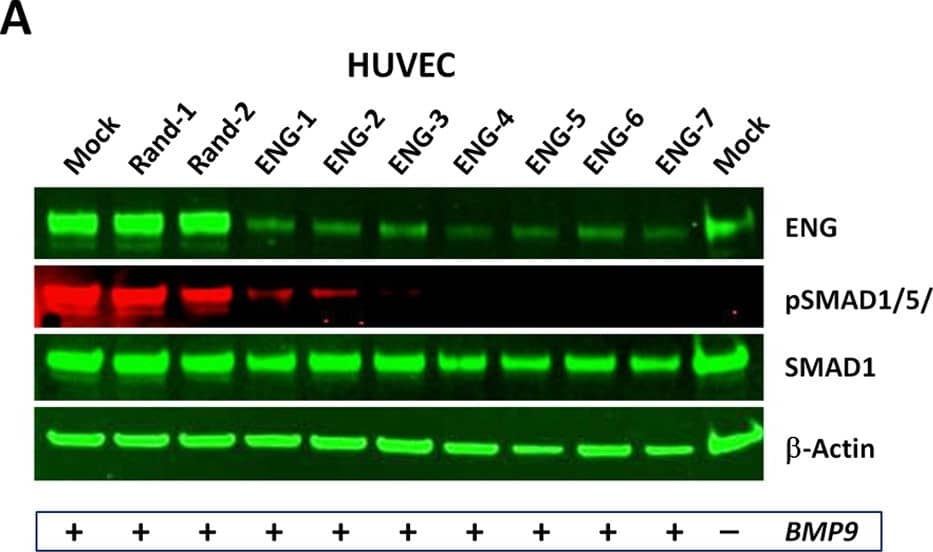Human/Mouse/Primate BMP-9 Antibody
R&D Systems, part of Bio-Techne | Catalog # MAB3209

Key Product Details
Species Reactivity
Validated:
Cited:
Applications
Validated:
Cited:
Label
Antibody Source
Product Specifications
Immunogen
Ser320-Arg429
Accession # Q9UK05
Specificity
Clonality
Host
Isotype
Endotoxin Level
Scientific Data Images for Human/Mouse/Primate BMP-9 Antibody
Alkaline Phosphatase Production Induced by BMP-9 and Neutralization by Human BMP-9 Antibody.
Recombinant Human BMP-9 (Catalog # 3209-BP) induces alkaline phosphatase production in the ATDC5 mouse chondrogenic cell line in a dose-dependent manner (orange line). Alkaline phosphatase production elicited by Recombinant Human BMP-9 (5 ng/mL) is neutralized (green line) by increasing concentrations of Mouse Anti-Human/Mouse/Primate BMP-9 Monoclonal Antibody (Catalog # MAB3209). The ND50 is typically 0.01-0.04 µg/mL.Detection of BMP-9 by Western Blot
ENG is required for BMP9-mediated SMAD1/5/8 phosphorylation in endothelial cells.A) HUVECs were reversed-transfected in a 96-well plate with Mock, Random or ENG siRNAs for 48 hours then serum-starved for 3 hours prior to stimulation with BMP9 (0.1 ng/ml) (+) or PBS (−). Levels of ENG, pSMAD1/5/8, SMAD1 and beta-Actin in the total cell extracts were measured by western blotting. (B–D) ECs were dispensed in each well of a 96-well plate (HUVEC, HPAEC, HAEC –2500 cells/well, MS1–1250 cells/well) in serum free media. Cells were incubated with antibodies at various concentrations for 1 hour and stimulated with BMP9 (0.1 ng/ml) (+) or PBS (−) for 30 min prior to lysis. Levels of pSMAD1 normalized for levels of total SMAD1 were monitored using a SMAD1/pSMAD1 MSD assay. The following antibodies were used: rIgG2a (rat IgG2a isotype control), M999 (rat IgG2a anti-human ENG), hIgG2 (human IgG2 isotype control), cSN6j (human IgG2 anti-human ENG), Ab3209 (mouse IgG2b anti-human BMP9), M1041-43 (rat IgG2a anti-mouse ENG). * Antibody concentrations of Ab3209 used were 10 times lower than other antibodies. Results are the mean +/− standard deviation of technical triplicates (** = P Value <10E-04; *** = P value <10E-03). Image collected and cropped by CiteAb from the following open publication (https://dx.plos.org/10.1371/journal.pone.0050920), licensed under a CC-BY license. Not internally tested by R&D Systems.Applications for Human/Mouse/Primate BMP-9 Antibody
Neutralization
Human/Primate BMP-9 Sandwich Immunoassay
Reviewed Applications
Read 1 review rated 5 using MAB3209 in the following applications:
Formulation, Preparation, and Storage
Purification
Reconstitution
Formulation
Shipping
Stability & Storage
- 12 months from date of receipt, -20 to -70 °C as supplied.
- 1 month, 2 to 8 °C under sterile conditions after reconstitution.
- 6 months, -20 to -70 °C under sterile conditions after reconstitution.
Background: BMP-9
Human BMP-9, also known as growth and differentiation factor 2 (GDF-2), is a member of the BMP subgroup of the TGF-beta superfamily proteins that signal through heterodimeric complexes composed of type I and type II BMP receptors. BMP-9 regulates the development and function of a variety of embryonal and adult tissues (1, 2). The human BMP-9 cDNA encodes a 429 amino acid (aa) precursor that includes a 22 aa signal sequence, a 298 aa propeptide, and a 111 aa mature protein (3). Unlike with other BMP family proteins, the propeptide does not interfere with the biological activity of BMP-9 and remains associated with the mature peptide after proteolytic cleavage (4). Human and mouse BMP-9 share 96% aa sequence identity. Within the mature protein, human BMP-9 shares 64% aa sequence identity with human BMP-10 and less than 50% aa sequence identity with other BMPs. BMP-9 is expressed by non-parenchymal cells in the liver, (5, 6) where it promotes lipid metabolism and inhibits glucose production (7). BMP-9 exerts a prolonged hypoglycemic effect which may be due to an enhancement of insulin release (7). BMP-9 interacts with a high affinity specific heteromeric receptor expressed on liver endothelial cells that has been identified as ALK-1 (4-6). In the embryonal CNS, BMP-9 functions in the development and maintenance of the cholinergic neuronal phenotype (8-10). BMP-9 also induces the differentiation of mesenchymal stem cells into the chondrogenic lineage (11, 12). At low concentrations, BMP-9 is a proliferative factor for hematopoietic progenitor cells, but at higher concentrations, it enhances TGF-beta 1 production and inhibits hematopoietic progenitor colony formation (13).
References
- Chen, D. et al. (2004) Growth Factors 22:233.
- Miyazono, K. et al. (2005) Cytokine Growth Factor Rev. 16:251.
- Celeste, A.J. et al. (1994) J. Bone Miner. Res. 9:S136.
- Brown, M.A. et al. (2005) J. Biol. Chem. 280:25111.
- Song, J.J. et al. (1995) Endocrinology 136:4293.
- Miller, A.F. et al. (2000) J. Biol. Chem. 275:17937.
- Chen, C. et al. (2003) Nat. Biotechnol. 21:294.
- Lopez-Coviella, I. et al. (2000) Science 289:313.
- Lopez-Coviella, I. et al. (2005) Proc. Natl. Acad. Sci. USA 102:6984.
- Lopez-Coviella, I. et al. (2002) J. Physiol. Paris 96:53.
- Majumdar, M.K. et al. (2001) J. Cell. Physiol. 189:275.
- Hills, R.L. et al. (2005) J. Orthoped. Res. 23:611.
- Ploemacher, R.E. et al. (1999) Leukemia 13:428.
Long Name
Alternate Names
Gene Symbol
UniProt
Additional BMP-9 Products
Product Documents for Human/Mouse/Primate BMP-9 Antibody
Product Specific Notices for Human/Mouse/Primate BMP-9 Antibody
For research use only

